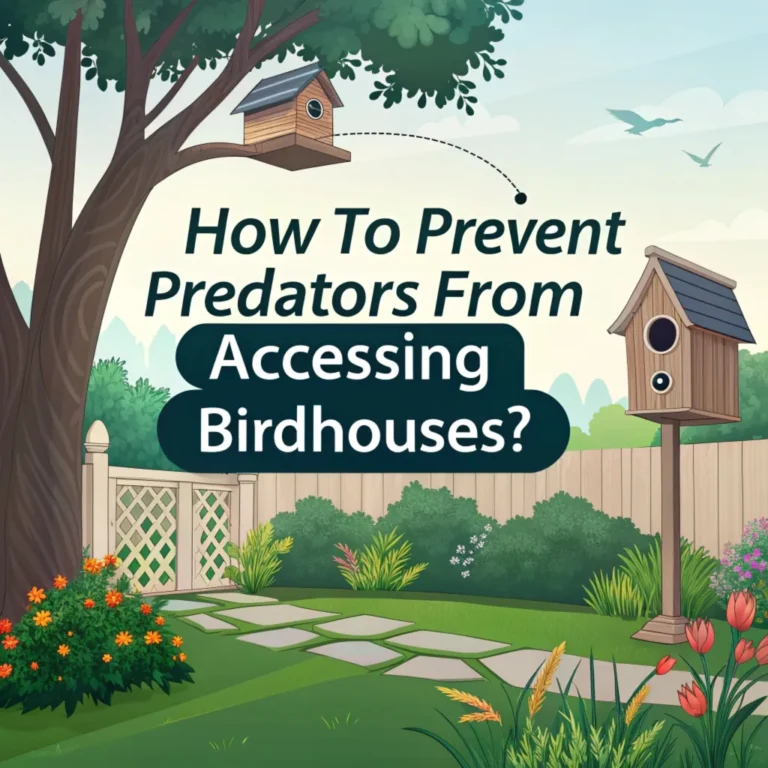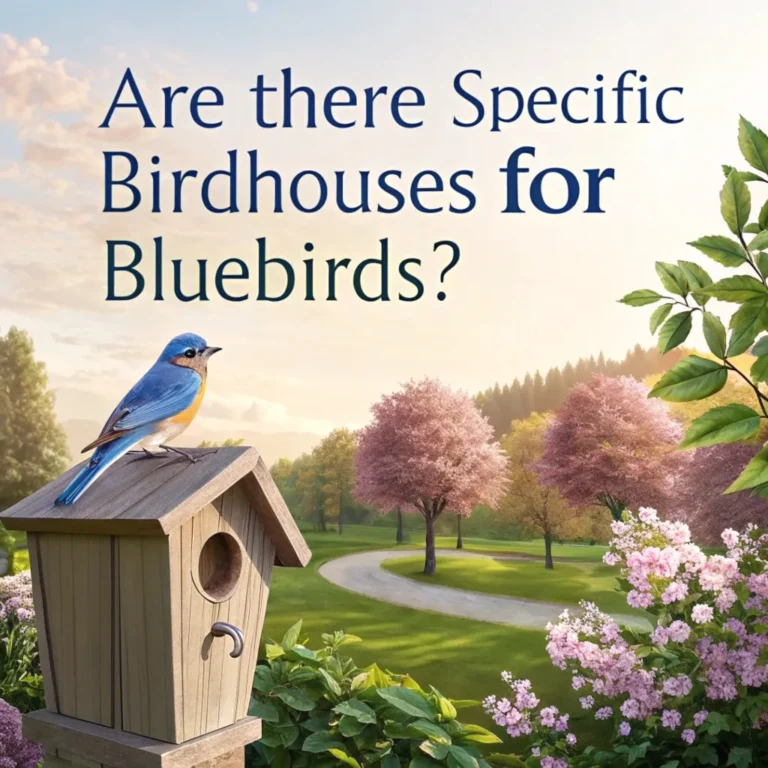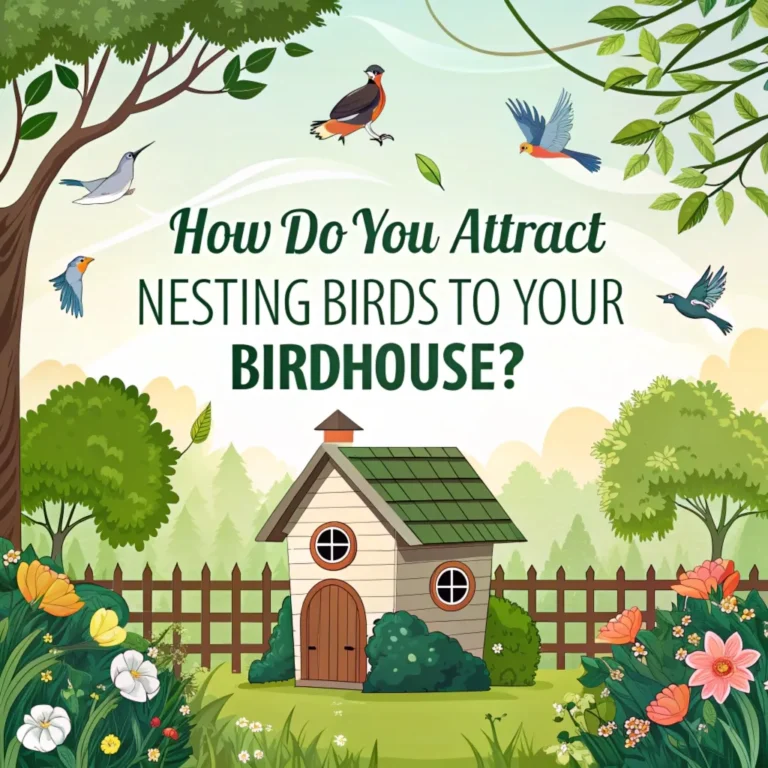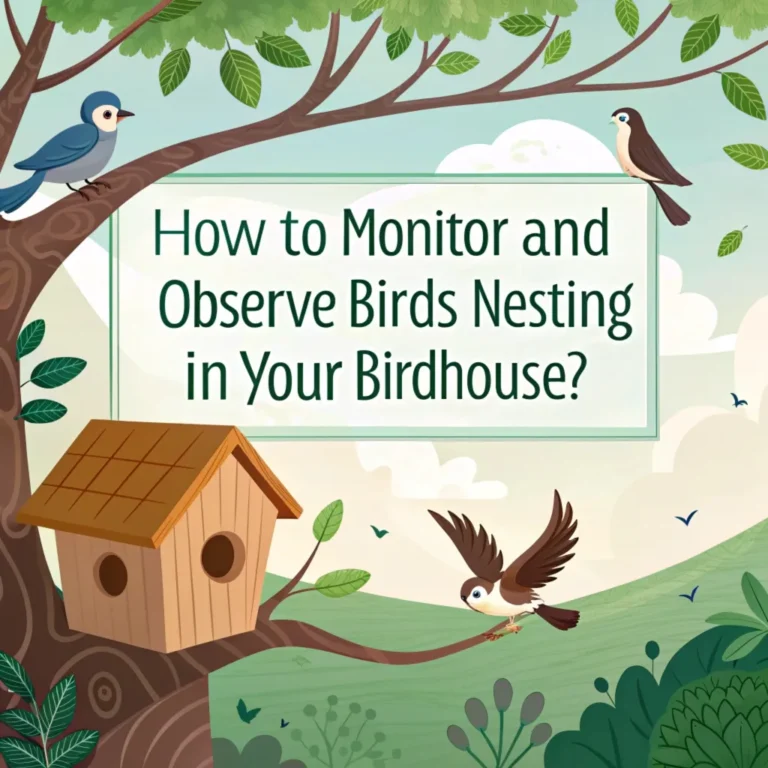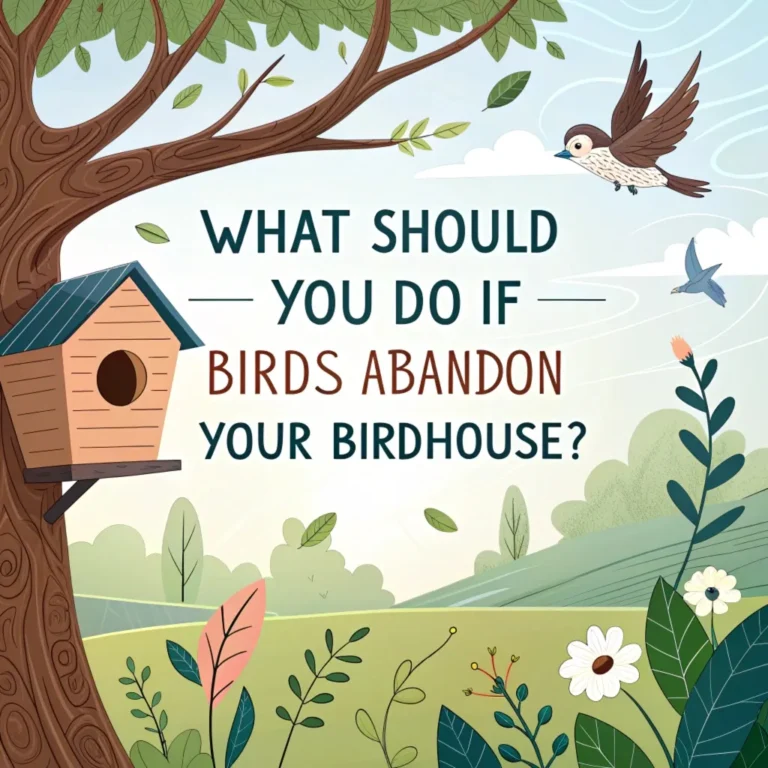Where is the Best Location to Place a Birdhouse? The Ultimate Guide
Birdhouses offer a wonderful way to bring nature closer to home. This guide helps you place birdhouses effectively. You will learn the best locations for birdhouses.
The guide covers height, direction, and safety. It also explains how to attract different bird species.
By following these tips, you can create a welcoming space for birds in your yard. This guide aims to help both new and experienced bird enthusiasts.
It provides clear, practical advice for successful birdhouse placement. With the right approach, you can turn your yard into a thriving bird habitat.

Key Takeaways
- Height matters: Place birdhouses 5-15 feet above ground, depending on species
- Face east: Orient entrance holes away from prevailing winds, typically eastward
- Provide shelter: Position near trees or shrubs for protection, but avoid dense cover
- Ensure safety: Mount on poles with baffles to deter predators
- Consider species preferences: Different birds prefer different habitats and heights
- Maintain distance: Keep birdhouses away from feeders, baths, and high-traffic areas
- Avoid pesticides: Place in areas free from harmful chemicals
- Secure mounting: Ensure birdhouses can withstand strong winds and weather
- Offer variety: Place multiple houses to attract different species
- Regular cleaning: Maintain birdhouses for continued occupancy
- Be patient: It may take time for birds to adopt new houses
Creating a bird-friendly environment in your yard is a rewarding experience that goes beyond simply placing a birdhouse. It involves understanding the delicate balance of nature and providing a safe haven for our feathered friends.
By carefully selecting the location for your birdhouse, you’re not just offering a nesting spot, but also contributing to local biodiversity and conservation efforts.
The art of birdhouse placement combines scientific knowledge with a touch of intuition. As you become more attuned to the needs and behaviors of different bird species, you’ll develop a deeper appreciation for the intricacies of avian life.
This journey of discovery can lead to a lifelong passion for birdwatching and environmental stewardship, enriching your life and benefiting the natural world around you.
Choosing the Right Height
The height of your birdhouse plays a crucial role in attracting birds. Most species prefer houses placed 5 to 15 feet above the ground. However, specific heights can vary:
- Bluebirds: 5-10 feet
- Chickadees and Wrens: 6-10 feet
- Purple Martins: 10-15 feet
Understanding the vertical preferences of different bird species is crucial for successful birdhouse placement. Each species has evolved to nest at specific heights that offer optimal protection from predators and environmental factors.
By matching the height of your birdhouse to the preferences of your target species, you significantly increase the chances of attracting nesting birds.
Consider the surrounding landscape when deciding on birdhouse height. In areas with taller trees or structures, you might need to place houses slightly higher to make them visible and attractive to birds.
Conversely, in more open areas, lower heights might suffice. Always prioritize the safety and accessibility of the birdhouse for both the birds and yourself during maintenance.
Proper Orientation

Face the entrance hole of your birdhouse away from prevailing winds. In North America, this typically means orienting the entrance eastward.
This positioning protects nests from harsh weather and keeps the interior cooler.
The orientation of a birdhouse is more than just a matter of comfort for its feathered inhabitants. It’s a critical factor in the success of nesting attempts.
A properly oriented birdhouse provides protection from harsh weather conditions, including strong winds and driving rain. This shelter is essential for maintaining a stable environment inside the nest, which is crucial for the development of eggs and young chicks.
Consider the local microclimate when orienting your birdhouse. While eastward-facing entrances are generally recommended, factors such as nearby buildings, trees, or geographical features might influence local wind patterns.
Observe your yard at different times of the day and in various weather conditions to determine the best orientation for your specific location. This attention to detail can make a significant difference in the attractiveness and functionality of your birdhouse.
Providing Adequate Shelter
Place birdhouses near trees or shrubs for natural protection. This offers shelter from wind, rain, and excessive heat. However, avoid placing houses too close to dense foliage, as this can harbor predators.
The concept of shelter extends beyond just the birdhouse itself. The surrounding environment plays a crucial role in creating a safe and attractive nesting site.
Natural vegetation provides multiple benefits, including protection from the elements, perching spots for adults, and foraging opportunities. However, striking the right balance is key – too much cover can make the birdhouse vulnerable to predators, while too little might leave it exposed.
Consider creating a diverse habitat around your birdhouse. A mix of trees, shrubs, and open spaces can attract a wider variety of bird species.
Native plants are particularly beneficial, as they provide familiar food sources and nesting materials. This holistic approach to birdhouse placement not only increases the likelihood of attracting nesting birds but also contributes to the overall health of your local ecosystem.
Ensuring Safety from Predators
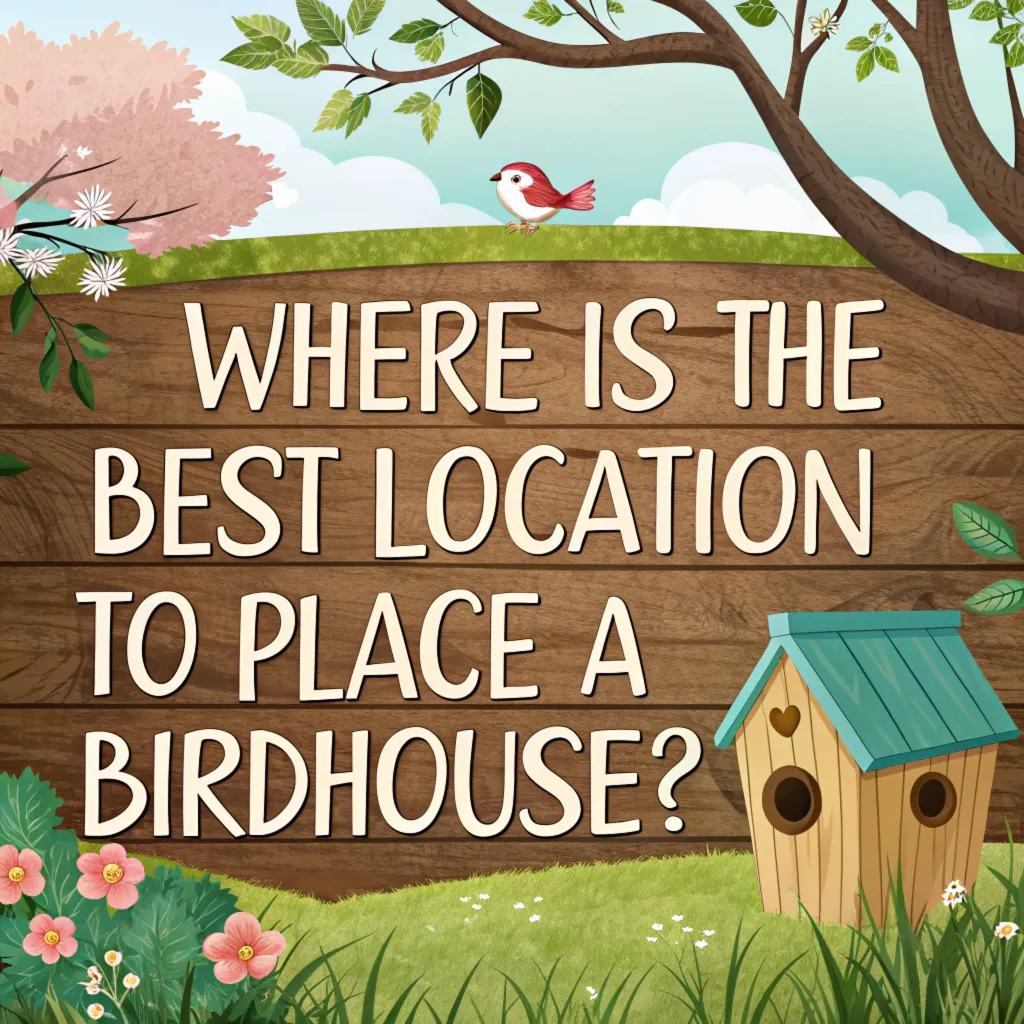
Mount birdhouses on poles with baffles to prevent access by predators like raccoons, cats, or snakes. If attaching to a tree, ensure it’s high enough and away from branches that could serve as access points for predators.
The threat of predation is a constant concern for nesting birds. Your role in providing a safe nesting site is crucial for the success of bird families.
Predator guards and baffles are not just accessories; they’re essential components of a well-designed birdhouse setup. These devices can significantly increase the survival rates of eggs and chicks, giving birds a better chance to raise their young successfully.
Consider the specific predators in your area when designing your birdhouse protection. For example, in areas with climbing predators like raccoons, smooth metal poles with baffles are highly effective.
In regions with aerial predators, providing some overhead cover or placing the birdhouse near (but not too close to) protective foliage can offer additional safety. Remember, a safe birdhouse is more likely to be used year after year, contributing to the long-term success of local bird populations.
Considering Species-Specific Preferences
Different bird species have varying habitat preferences:
- Bluebirds, Swallows, Wrens: Open areas like fields or meadows
- Chickadees, Nuthatches: Partially wooded areas
Understanding the unique preferences of different bird species is key to successful birdhouse placement. Each species has evolved to thrive in specific habitats, and replicating these conditions in your yard can significantly increase the chances of attracting your target species.
Research the native birds in your area and tailor your birdhouse placement to their natural preferences.
Consider creating multiple habitat zones in your yard to attract a diverse range of species. For example, you might have an open area with a bluebird house, a partially wooded section with houses for chickadees and nuthatches, and perhaps a martin house in a more elevated, open location.
This diversity not only increases your chances of attracting different species but also contributes to a more balanced and healthy backyard ecosystem.
Maintaining Distance from Other Bird Amenities
Place birdhouses at least 10 to 20 feet away from bird feeders or birdbaths. This reduces disturbances and minimizes the risk of attracting predators to the nest.
The spatial arrangement of bird amenities in your yard is crucial for creating a harmonious environment. While it might seem logical to group all bird-related items together, this can actually create problems for nesting birds.
Feeders and baths, while beneficial, can attract a high volume of bird traffic, which can be disruptive to nesting pairs. Additionally, these high-activity areas can draw the attention of predators, potentially putting nesting birds at risk.
Consider creating distinct zones in your yard for different bird activities. Nesting areas should be quieter and more secluded, while feeding and bathing areas can be more centrally located. This separation allows birds to engage in different behaviors without conflict.
For example, a nesting pair can retreat to their quiet birdhouse after visiting a feeder, maintaining a balance between socialization and privacy.
This thoughtful layout can make your yard more attractive to a wider variety of birds and increase the overall success of nesting attempts.
Avoiding Pesticide-Treated Areas
Ensure birdhouses are placed in areas free from pesticides and herbicides. These chemicals can harm birds and eliminate their food sources.
The impact of pesticides on bird populations cannot be overstated. These chemicals not only pose direct health risks to birds but also decimate insect populations, which are crucial food sources for many bird species, especially during breeding season.
By placing birdhouses in pesticide-free areas, you’re providing a safe haven for birds to raise their young and contributing to the overall health of the local ecosystem.
Consider adopting organic gardening practices in the areas surrounding your birdhouses. This approach not only creates a safer environment for birds but also promotes a more balanced ecosystem.
Natural pest control methods, such as companion planting and encouraging beneficial insects, can help maintain a healthy garden without resorting to harmful chemicals.
This holistic approach to yard management can transform your space into a thriving habitat that supports a diverse range of wildlife, with nesting birds as a centerpiece of this miniature ecosystem.
Secure Mounting
Use sturdy mounting methods to ensure birdhouses can withstand strong winds and severe weather. Free-standing metal poles or PVC pipes offer advantages such as:
- Higher mounting options
- Difficulty for predators to climb
- Easy addition of predator guards
The stability of your birdhouse is paramount for the safety of its inhabitants. A securely mounted birdhouse provides birds with a sense of security, encouraging them to nest and return year after year.
Unstable or poorly mounted houses can sway in the wind, potentially causing stress to nesting birds or even resulting in fallen nests. By investing time in proper mounting, you’re creating a long-lasting, reliable home for generations of birds.
Consider the long-term durability of your mounting system. While it might be tempting to opt for quick and easy solutions, investing in high-quality, weather-resistant materials will pay off in the long run.
Regularly inspect your birdhouse mounts, especially after severe weather events, to ensure they remain secure.
This ongoing maintenance not only protects the birds but also allows you to develop a deeper connection with the wildlife in your yard, observing changes and adaptations over time.
Offering Variety
To attract a diverse bird population, consider pairing birdhouses. Place boxes 15 to 25 feet apart or back-to-back on a single pole. This allows species like Tree Swallows and Bluebirds to nest near each other while maintaining their territories.
Creating a diverse birdhouse community in your yard can lead to fascinating observations of interspecies interactions. Different bird species have varying nesting habits and social behaviors.
By offering a variety of birdhouse styles and placements, you’re essentially creating a microcosm of avian society. This diversity not only increases the chances of attracting multiple species but also contributes to a more balanced and resilient backyard ecosystem.
Consider the ecological relationships between different bird species when planning your birdhouse layout. Some species are more tolerant of close neighbors, while others require more space.
By understanding these dynamics, you can create an environment that minimizes conflict and maximizes nesting success.
For example, pairing bluebird houses with tree swallow houses can actually benefit both species, as they often coexist peacefully and may even help defend each other’s territories from predators.
Regular Maintenance
Choose birdhouses with easy-to-open designs for regular cleaning. Remove nesting material and debris after each breeding season to prevent parasites and prepare the house for future occupants.
The importance of maintenance extends beyond just cleanliness. Regular checks and cleaning of birdhouses play a crucial role in the health and success of nesting birds.
Parasites and old nesting material can harbor diseases that can be detrimental to new broods. By maintaining clean, healthy nesting sites, you’re significantly improving the chances of successful breeding and fledging of young birds.
Develop a maintenance schedule that aligns with the breeding cycles of your local bird species. This typically involves a thorough cleaning at the end of each breeding season, but may also include periodic checks during the active nesting period.
Use these maintenance sessions as opportunities to observe and learn about the nesting habits of different species. Keep a log of your observations, noting which houses are used, by what species, and any interesting behaviors you notice.
This practice not only helps you become a better steward of your backyard habitat but also contributes valuable data to citizen science projects focused on bird conservation.
Patience is Key
After placing a birdhouse, be patient. It may take a season or two for birds to adopt it, especially if installed later in spring.
The process of attracting nesting birds is as much about patience as it is about proper placement. Birds are naturally cautious creatures, and it takes time for them to recognize and trust a new structure in their environment.
This waiting period is an excellent opportunity to observe and learn about the birds in your area. Pay attention to their behaviors, preferred habitats, and interactions.
This knowledge will not only help you refine your birdhouse placement strategy but also deepen your appreciation for the complex lives of these feathered neighbors.
Use this waiting period productively by continuing to enhance your yard’s bird-friendly features. Plant native species that provide food and shelter, create water sources, and maintain a pesticide-free environment.
These efforts will make your yard more attractive to birds in general, increasing the likelihood that they’ll eventually discover and use your birdhouses.
Remember, creating a bird-friendly habitat is an ongoing process, and each improvement you make contributes to the overall appeal of your yard to nesting birds.
FAQs
How high should I place my birdhouse?
Most birdhouses should be placed 5 to 15 feet above the ground, depending on the species you want to attract.
What direction should the entrance of my birdhouse face?
In North America, birdhouse entrances should typically face east to protect from prevailing winds and direct sunlight.
How far apart should multiple birdhouses be placed?
For most species, place birdhouses 15 to 25 feet apart. Some territorial birds may require more distance, up to 100-300 feet.
Can I place a birdhouse near my bird feeder?
It’s best to place birdhouses at least 10 to 20 feet away from bird feeders to reduce disturbances and predator attraction.
How often should I clean my birdhouse?
Clean birdhouses after each brood leaves the nest, which can be 1-3 times per season.
By following these guidelines, you’ll create an inviting environment for birds to nest in your yard. Remember, the key to successful birdhouse placement is understanding the needs of the species you want to attract and providing a safe, comfortable home for them.

Luna is the passionate founder and author of Birds and You, a website dedicated to sharing her love for birds with fellow enthusiasts. Through her engaging articles and guides, she aims to educate and inspire others to explore the fascinating world of birds. When she’s not writing, you can find Luna observing birds in their natural habitats or sharing beautiful bird photography on Pinterest. Join her on this journey to celebrate and protect our feathered friends!


